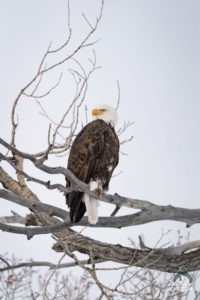Bald Eagles

Today I wanted to take the time to talk about, one of my favorite birds, the bald eagle! – the American Emblem since 1782! The bald eagle is often a synonym of strength, courage, and freedom. You can find it on American passports, flags, documents, and money. It is a classic icon!

There exists many different species of eagles in the world and most of them are not social. However, bald eagles are easily recognizable by their white heads and tails, brown bodies, and yellow beaks. The first time I saw them I was very impressed by their size. An eagle’s height is around 2.7 feet (0.8m) and its wingspan is 6.7 feet (2m). This makes the bald eagle the 3rd largest North American bird of prey behind the Golden Eagle and the California Condor.
They are the most common in Alaska and the Washington States area, you can also see them in other states but mostly in the winter when they migrate south. Some Bald Eagles are known as Sea Eagles, they eat mostly fish, but they can eat rabbits, beavers, crabs, or animals that have already died. However, they do prefer fish, that is why you can find them near the water surrounded by large old trees where they can nest.
Mate for Life
It is true the bald eagle chose a mate for life and each year they return to the same nest, making it stronger and bigger. Most of the time a couple of eagles have two eaglets. Unfortunately, one of these babies has a higher chance of not surviving than the other. This is because of the size of the nest and the battle for food. One eaglet will become bigger and more powerful and they do not share!
The weaker eaglet will slowly grow weaker and eventually be pushed out of the nest. It is easy to spot a young bald eagle (also called Juveniles) as its plumage will not be white yet (see picture on the left). They will reach adulthood and get their emblematic colors after 4 to 5 years of age! These colors are why they are called “Bald” eagles, because they are losing their head plumage color with time!
And what about wintertime?

Bald eagles will migrate north, right up until there is too much ice to fish. During the winter months, bald eagles are widely found throughout much of the continental United States. Some bald eagles do not migrate if they find a place warm enough in the winter. This is the case in the Teton mountains, Wyoming. In the park and its surrounding area, the bald eagle can be spotted all year round! However, Alaskan bald eagles migrate south when lakes and rivers near their nesting grounds freeze over.
Like most animals and birds their food supply is the most important factor and will impact all their decisions!
It is always with great pleasure and excitement that I watch these beautiful predators in their natural habitat. I have seen them in Wyoming, Minnesota, Alaska, Washington, California and a few other States! If you travel to the US make sure to keep an eye in the sky!

Fun Facts
- The word “bald” does not mean hairless in their case — it is actually referring to the white of their head and upper neck.
- They can live up to 30 years in the wild.
- As an adult, they do not have any predators (in the wild)
- Bald Eagles are good swimmers and can swim to shore if their catch is too big/heavy to fly away.
- Bald Eagles nest is the largest tree nest in the world as it keeps growing each year! Their average nest size is 4 to 5 feet in diameter and 2 to 4 feet deep. Each year the adult pair will add 1-2 feet to the nest.
- Eagles will return to the same nest and nesting territory each year
Links
Watch the live cam of a bald eagle nest in Big Bear, CA : Here
Want to read more articles: Here
Please leave your questions or subject you want me to talk about in the comment section below!
2 Comments
Jean-Phi
Thanks Camille for this posting, useful, I have learnt a lot about this famous eagle , emblem of the US nation since 1782!
Mark
Thanks for your blog, nice to read. Do not stop.